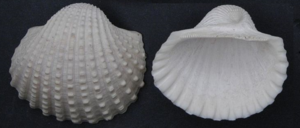Red-fleshed ark shell
| Red-fleshed ark shell | ||||||||||||
|---|---|---|---|---|---|---|---|---|---|---|---|---|

Tegillarca granosa |
||||||||||||
| Systematics | ||||||||||||
|
||||||||||||
| Scientific name | ||||||||||||
| Tegillarca granosa | ||||||||||||
| ( Linnaeus , 1758) |
The red-fleshed ark mussel ( Tegillarca granosa ) is a type of mussel from the family of ark mussels (Arcidae). In Southeast Asia it is cultivated in tidal areas and is of great economic importance.
features
The same-folding, very bulbous housing is up to 9 cm in size, usually around 6 cm. It is almost equilateral, with the large, forward-curled vertebrae just a little in front of the midline. It is egg-shaped in outline and only slightly longer than it is tall. The height reaches between 75 and 90% of the length. The thickness (bulging) is between 66 and 82% of the length. The dorsal margin is straight. The anterior and posterior ends of the dorsal margin are angled. The rear edge is truncated, the front edge slightly arched. The ventral margin is almost straight in the central area. The ligament is narrow and rhomboidal with three to four dark, angled markings. It's essentially behind the vertebrae. The teeth have 40 to 68 teeth that are perpendicular to the lock plate. They get a little longer towards the front and back edges. The posterior sphincter is rounded and rectangular, but the anterior sphincter is roughly the same shape but slightly smaller.
The whitish skin is very thick and firm. The ornamentation consists of approx. 18 to 21 radial ribs at regular intervals, which are flat-rectangular in cross-section or are dissolved into rectangular nodes. In some populations, the nodes can be slightly curved and slightly pointed. The spaces between the ribs are slightly wider than the ribs themselves. The yellow-brown to dark-brown periostracum is smooth. The inner edge of the housing is notched to match the outer ribs. The inside of the bowl is white.
The soft body is red. The blood pigment hemoglobin is responsible for the coloring . The foot is quite large, narrowed at the sides with a central longitudinal furrow.
Geographical distribution, habitat and way of life
The distribution area of the species stretches from East Africa to Melanesia , in the north to southern Japan , in the south to northern and eastern Australia .
The animals live in shallow water to a depth of about 20 meters, preferably in the tidal area on muddy bottoms. They dig shallow in the sediment and filter their food, mostly phytoplankton and unicellular algae as well as organic detritus from the water.
development
The animals are of separate sex. The red-fleshed ark mussel spawns from August to February of the following year. A female can produce between 518,400 to 2,313,200 eggs. The animals become sexually mature at one to two years. They are very tolerant of fluctuations in salinity. The optimal temperature for their growth is between 20 and 30 ° C. The animals live to be around three years old.
Taxonomy
The species was founded in 1758 by Carl von Linné in the original combination of Arca granosa . It is the type species of the genus Tegillarca Iredale, 1939. It is generally recognized as a valid species.
Molecular biological studies show that the red-fleshed ark mussel ( Tegillarca granosa ) and Tegillarca nodifera form a small monophylum . However, this is placed in the middle of the genus Anadara Gray, 1847. According to these results, either the genus Anadara is polyphyletic in the previous extent or Tegillarca must be combined with Anadara .
According to the large distribution area, there are a number of synonyms : Anadara bisenensis Schrenck & Reinhart, 1938, Anadara thackwayi Iredale, 1927, Anomalocardia pulchella Dunker, 1868, Arca aculeata Bruguière, 1789, Arca corbicula Gmelin, 1791, Arca Corbula Dillwyn, 1817 Arca granosa kamakuraensis Noda, 1966, Arca nodulosa Lightfoot, 1786 (invalid, younger homonym of Arca nodulosa OF Müller, 1776), Arca obessa Kotaka, 1953 and Tegillarca (granosa) bessalis Iredale, 1939 (uncertain rank, species or subspecies?).
Economic importance and seafood
The species is cultivated in the coastal areas of China , Taiwan , Korea , Malaysia and Thailand in shallow tidal areas of the sea. By 2016 the annual production had risen to around 450,000 tons.
In Korea, the red-fleshed ark shell is called kkomak ( 꼬막 ). The animals are boiled and treated with soy sauce , chilli , sesame oil and the like. a. seasoned and prepared.
kkomak- muchim
supporting documents
literature
- FR Bernard, Ying-Ya Cai, Brian Morton: A Catalog of the Living Marine Bivalve Molluscs of China: Critical Essays. 146 S., Hong Kong Univ. Press, Hong Kong 1993 ISBN 962-209-324-8
- S. Peter Dance, Rudo von Cosel (arrangement of the German edition): The great book of sea shells. 304 p., Verlag Eugen Ulmer, Stuttgart, 1977 ISBN 3-8001-7000-0 (p. 224)
- KA Narasimham: Taxonomy of the blood clams Anadara (Tegillarca) granosa (Linnaeus, 1758) and A. (T.) rhombea (Born, 1780). Journal of the marine biological Association of India , 30 (1/2): 200-205, 1988 PDF
Individual evidence
- ^ Wilhelm Kobelt: The genus Arca L. In illustrations after nature with descriptions. Systematic Conchylia Cabinet by Martini and Chemnitz, 8 (2): 1-238, Nuremberg 1891 Online at www.biodiversitylibrary.org (p. 38), plate 3 .
- ^ Carl von Linné: Systema naturae per regna tria naturae, secundum classes, ordines, genera, species, cum characteribus, differentiis, synonymis, locis. Tomus I. Editio decima, reformata. Pp. 1-824, Holmia / Stockholm, Salvius, 1758. Online at www.biodiversitylibrary.org (p. 694).
- ↑ a b MolluscaBase: Tegillarca granosa (Linnaeus, 1758)
- ↑ David J. Combosch, Gonzalo Giribet: Clarifying phylogenetic relationships and the evolutionary history of the bivalve or Arcida (Mollusca: Bivalvia: Pteriomorphia). Molecular Phylogenetics and Evolution, 94: 298-312, 2016, doi : 10.1016 / j.ympev.2015.09.016 , PDF
- ↑ FAO Species Fact Sheets: Anadara granosa (Linnaeus, 1758)
- ↑ Da-young Chung: Cockles . In: KOREA , Korean Culture and Information Service, December 2015. Retrieved June 11, 2017.



